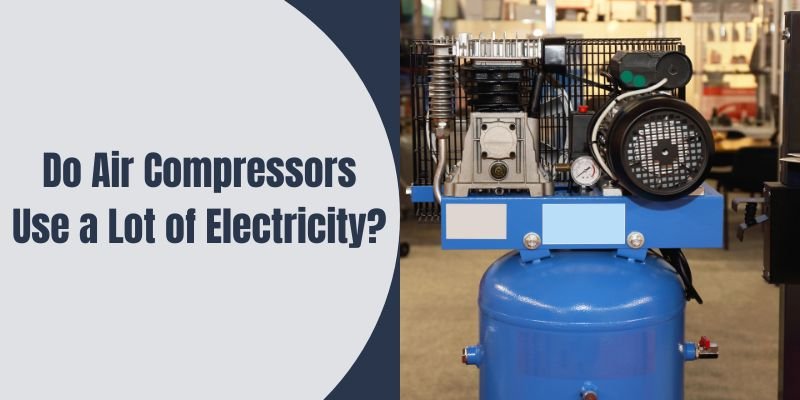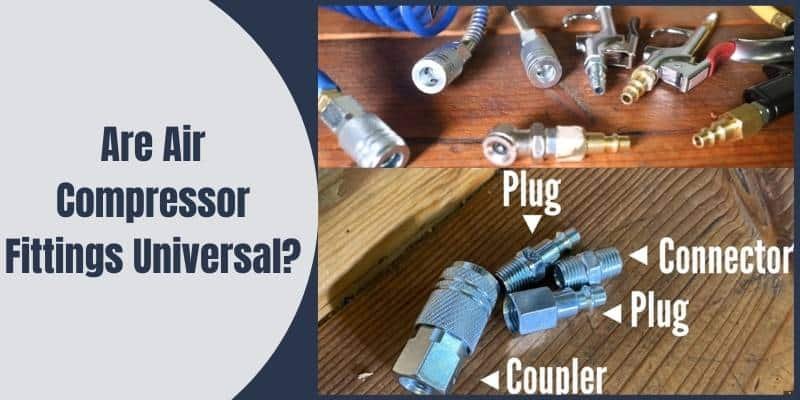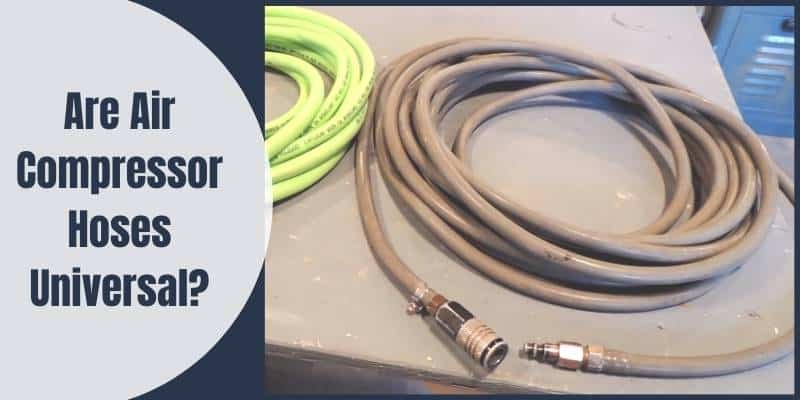Disclosure: This post contains affiliate links and I will be compensated if you make a purchase after clicking through my links. Learn More
Do Air Compressors Use a Lot of Electricity? If you’ve ever wondered about the electricity consumption of these essential tools, you’re not alone. In this guide, we’ll dive into the fascinating world of air compressor energy usage and find out common misconceptions.

Do Air Compressors Use a Lot of Electricity?
Air compressors are essential machines used in various applications, from industrial settings to home workshops. One common concern among users is whether air compressors consume a significant amount of electricity.
The electricity consumption of an air compressor depends on several factors, including its size, type, usage patterns, and efficiency. Larger and more powerful air compressors generally consume more electricity than smaller ones. However, advancements in technology have led to the development of energy-efficient air compressors that can significantly reduce electricity usage.
To determine if an air compressor uses a lot of electricity, consider its motor’s horsepower (HP) rating and the volume of air it can deliver per minute (CFM). Higher HP ratings and CFM values generally result in higher electricity consumption. Additionally, the duty cycle, which represents the amount of time the compressor runs in a given period, affects electricity usage.
Overall, while air compressors do use electricity, selecting an energy-efficient model and employing proper usage and maintenance practices can help manage electricity costs effectively.
Factors Affecting the Electricity Consumption of an Air Compressor
Several factors influence the electricity consumption of an air compressor. Understanding these factors can help users make informed decisions when selecting and operating their air compressors.
Size and Horsepower
Larger air compressors with higher horsepower ratings tend to consume more electricity. When choosing an air compressor, consider the required airflow and pressure to avoid using a larger and more energy-consuming compressor than necessary.
Type of Air Compressor
Different types of air compressors, such as reciprocating, rotary screw, and centrifugal, have varying energy efficiencies. Rotary screw compressors are often more energy-efficient than reciprocating ones, especially for continuous operation.
Duty Cycle
The duty cycle represents the percentage of time an air compressor can run within a given time frame. Compressors with higher duty cycles can handle continuous operation, but they may consume more electricity if operated constantly.
Air Demand
The air demand of the application influences the compressor’s electricity consumption. If the air demand is high and consistent, the compressor may use more electricity to meet the demand.
Air Leaks
Air leaks in the compressor system can lead to increased energy consumption. Regularly inspect and repair any leaks to maintain efficiency.
Compression Ratio
The compression ratio, which is the ratio of discharge pressure to intake pressure, affects energy consumption. Higher compression ratios require more energy.
Operating Pressure
Adjusting the operating pressure to the minimum required for the application can save energy.
Cooling System
Efficient cooling systems can help reduce energy consumption during compression.
By considering these factors, users can choose an air compressor that aligns with their specific needs and optimize its electricity consumption through proper usage and maintenance.
Energy-Efficient Air Compressors: Making the Right Choice
Energy efficiency is a crucial consideration when choosing an air compressor, as it directly impacts electricity consumption and operating costs. Energy-efficient air compressors are designed to minimize wasted energy, leading to significant savings over time.
When shopping for an energy-efficient air compressor, consider the following features:
Variable Speed Drive (VSD): Air compressors equipped with VSD technology can adjust the motor speed to match the air demand. This results in less energy wastage during periods of lower demand.
Low Leakage Design: Look for air compressors with low leakage rates to minimize energy losses.
High Efficiency Motors: Air compressors with high-efficiency motors can reduce electricity consumption significantly.
Thermal Mass Storage: Some compressors come with thermal mass storage systems that capture and reuse heat generated during compression, improving overall efficiency.
Energy Star Certification: Check for Energy Star-certified air compressors, as they meet strict energy efficiency guidelines.
Air Receiver Tank: Air compressors with larger receiver tanks can operate more efficiently, as they reduce the need for the compressor to start and stop frequently.
Oil-Free Technology: Oil-free compressors eliminate the need for oil maintenance and reduce energy consumption.
Remember to assess your specific air demand and usage patterns to choose the most suitable energy-efficient air compressor for your needs.
Managing the Electricity Cost of Running an Air Compressor
Running an air compressor can contribute to electricity expenses, especially in industrial settings with high air demand. To manage the electricity cost effectively, consider the following strategies:
Optimize Usage: Use the air compressor only when necessary and avoid running it at full capacity if lower pressures can suffice.
Regular Maintenance: Keep the air compressor well-maintained to ensure optimal performance and energy efficiency.
Monitor Air Leaks: Regularly inspect the system for air leaks and repair them promptly to prevent energy waste.
Pressure Adjustments: Adjust the operating pressure to the minimum required for the application to reduce energy consumption.
Energy-Efficient Upgrades: Consider upgrading to an energy-efficient air compressor if your current one is outdated and consumes excessive electricity.
Compressor Sequencing: If you have multiple compressors, use a compressor sequencing controller to optimize their operation and reduce energy consumption.
Power Factor Correction: Implement power factor correction if needed to improve energy efficiency.
By implementing these practices, users can minimize the electricity cost of running their air compressors while maintaining optimal performance.
Reducing the Electricity Consumption of an Air Compressor
Reducing the electricity consumption of an air compressor is a goal for both cost savings and environmental sustainability. Several steps can be taken to achieve this:
Energy Audit: Conduct an energy audit to identify areas of improvement in the compressor system and overall energy usage.
Load Profile: Analyze the load profile of the air compressor to understand usage patterns and optimize operation.
VSD Technology: Consider upgrading to an air compressor with Variable Speed Drive (VSD) technology to match air demand with motor speed.
Leak Detection and Repair: Regularly inspect the system for air leaks and fix them promptly to prevent energy wastage.
Efficient Piping: Use high-quality and properly sized compressed air piping to minimize pressure drops and energy losses.
Pressure Regulators: Install pressure regulators to ensure that each application receives the required pressure without excess waste.
Storage: Use compressed air storage to reduce the need for constant compressor operation.
Compressed Air Dryers: Implement efficient compressed air dryers to remove moisture and improve overall system efficiency.
Timed Shutdowns: Consider using timed shutdowns during periods of low demand to save energy.
Employee Training: Educate employees about energy-saving practices and the importance of using compressed air judiciously.
By adopting these measures, businesses and individuals can significantly reduce their air compressor’s electricity consumption and contribute to a greener and more cost-effective operation.
Using Renewable Energy Sources for Air Compressors
As sustainability becomes a priority for many industries, integrating renewable energy sources with air compressors is gaining popularity. By harnessing renewable energy, users can further reduce their carbon footprint and dependence on traditional electricity sources.
Several renewable energy options can be considered for powering air compressors:
Solar Power: Solar panels can be installed to generate electricity for air compressors, especially in locations with ample sunlight.
Wind Power: In windy regions, wind turbines can provide a consistent and renewable energy source.
Biomass: Biomass-based power generation can be explored, using organic materials to produce electricity.
Hydropower: Where feasible, hydropower can be harnessed to power air compressors.
Geothermal Energy: In regions with geothermal activity, geothermal energy can be utilized.
Integrating renewable energy sources with air compressors may require initial investments in equipment and infrastructure, but it can lead to long-term savings and environmental benefits.
Comparing Electricity Usage Among Different Air Compressor Types
Air compressors come in various types, each with its own advantages and disadvantages. When comparing electricity usage among different air compressor types, consider the following:
Reciprocating Compressors
Reciprocating compressors are generally less energy-efficient, especially at higher pressure settings. They are best suited for intermittent use and lower air demands.
Rotary Screw Compressors
Rotary screw compressors are more energy-efficient than reciprocating compressors, especially when operated continuously at a constant load.
Centrifugal Compressors
Centrifugal compressors are highly efficient for large-scale industrial applications. They are best suited for continuous operation at high flow rates and pressures.
Oil-Lubricated vs. Oil-Free
Oil-lubricated compressors may have slightly lower energy efficiency due to energy losses associated with lubrication. Oil-free compressors eliminate this concern but may have higher initial costs.
Portable vs. Stationary
Portable air compressors may have slightly lower energy efficiency due to their compact design and need for portability. Stationary compressors can be optimized for efficiency in specific applications.
Single-Stage vs. Two-Stage
Two-stage compressors are generally more energy-efficient than single-stage compressors, especially at higher pressure requirements.
When comparing air compressor types, consider the specific application requirements, air demand, and usage patterns to choose the most suitable and energy-efficient option.
Optimizing Air Compressor Electricity Efficiency through Maintenance
Regular maintenance is essential for optimizing the electricity efficiency of an air compressor. Neglecting maintenance can lead to decreased performance and increased energy consumption. Here are some maintenance practices to consider:
Air Filter Cleaning/Replacement: Clean or replace the air filter regularly to ensure proper airflow and prevent energy waste.
Oil Level and Quality: Check the compressor’s oil level and condition regularly. Contaminated or low-quality oil can reduce efficiency.
Cooling System: Keep the cooling system clean and free from debris to prevent overheating and reduce energy waste.
Tighten Fittings: Regularly inspect and tighten fittings to prevent air leaks.
Condensate Drains: Clean condensate drains regularly to ensure proper function and prevent pressure losses.
Belt Tension: Check and adjust the belt tension as necessary to maintain efficient power transmission.
Valve Maintenance: Regularly inspect and clean valves to ensure proper operation and minimize energy losses.
Motor and Drive Maintenance: Keep the motor and drive components well-maintained to ensure optimal efficiency.
By adhering to a regular maintenance schedule and promptly addressing any issues, users can maximize their air compressor’s electricity efficiency and reduce operating costs.
Benefits of Using Energy-Efficient Air Compressors in Industrial Settings
Using energy-efficient air compressors in industrial settings can lead to various benefits, both economic and environmental:
Cost Savings: Energy-efficient compressors consume less electricity, leading to reduced operational costs.
Lower Carbon Footprint: Energy-efficient compressors produce fewer greenhouse gas emissions, contributing to environmental sustainability.
Longer Lifespan: Energy-efficient compressors are often built with high-quality components, leading to longer operational lifespans.
Enhanced Productivity: Reliable and efficient air compressors ensure consistent and optimal performance, supporting industrial processes.
Compliance with Regulations: Using energy-efficient equipment can help industries comply with environmental regulations and standards.
Reputation and Brand Image: Companies that prioritize energy efficiency and sustainability can enhance their brand image and reputation.
Incentives and Rebates: Some regions offer incentives and rebates for businesses that invest in energy-efficient equipment.
Incorporating energy-efficient air compressors into industrial operations is not only financially prudent but also contributes to a greener and more sustainable future.
Conclusion
Air compressors can use a significant amount of electricity, but several factors influence their electricity consumption. Selecting energy-efficient air compressors, understanding usage patterns, and adopting proper maintenance practices are essential for managing electricity costs effectively.
Additionally, integrating renewable energy sources and comparing different compressor types can further enhance energy efficiency and sustainability.
By taking these steps, businesses and individuals can reduce their environmental impact and achieve long-term cost savings while enjoying the benefits of reliable and efficient air compressor operations.


